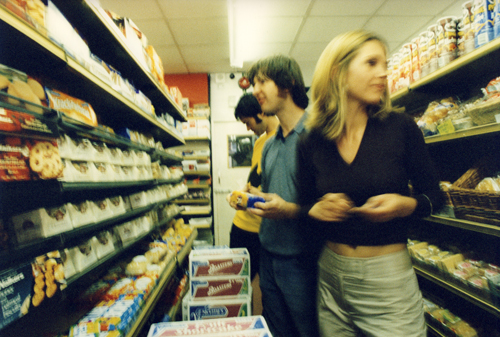When I was a kid I was quite scared of London
My dad worked near London Bridge. This must have been the late 60s, and a lot of the buildings were still covered in soot – it’s something you hardly ever see any more, but on St. Giles Street, round the back of Centrepoint, there’s a row of shops there that still look like that. But my memory of London was that it was all black and sooty.
Croydon was the complete opposite
It was like a Captain Scarlett set, all very clean, with flyovers and underpasses. That was the centre of Croydon, but where I lived it was all privet hedges and classic 30s suburbia. There’s definitely a good side to suburbia, but I think I was living a very cosseted part of England. Before I moved to London it never really held much interest for me. But then I got into the Festival of Britain and post war architecture. It made me understand why I loved Croydon where most people can’t stand it, and finding out the whole history of how the town developed after the war. It was quite morally awful, shunting people out of what was quite a nice market town to build huge office blocks for purely commercial reasons.
Modernist living is for me
I live in High Point. It was built in 1935 by the Tecton Group. Berthold Lubetkin was the architect. It’s the best modernist block of flats in Britain. He deliberately designed it so that anyone who was sniffy about modernism would walk in and instantly be impressed by the huge lobby. The flats are blank canvases, it’s got underfloor heating and there’s no clutter. I can’t imagine living anywhere better. There’s so much light, which is really important. The Victorians thought having too much light was wrong, they equated it with a liberal lifestyle. So in the 80s when you got that architecture coming back it made sense, this Thatcherite, self-flaggelating idea that you shouldn’t have too much light in the house. That seems to have stuck with the Barrett Homes style of building.
London’s architecture has both evolved and been subjected to violent revolution
I think it’s also to with people having the attitude of ‘ooo you can’t do that’. Like John Nash wanting to rebuild the centre of London. Regent Street was supposed to be his parade down to the river, but there’s always someone going ‘no you can’t pull that down’. Because of that, everything’s been piecemeal, no matter how great the architect this attitude has got in the way. London is unique because of that. Cities like Paris and Barcelona have been completely rebuilt at some point. We’ve got Rosebury Avenue, Shaftesbury Avenue, which are quite Parisian, but they were just cutting through slums.
Modernism got a bad rep
Flats are cheaper in Britain than houses – people in Britain don’t want to live in flats. I think if the flats had been up to par, it wouldn’t be like that. When people moved into the first wave of post war flats, people loved them. They were really happy with them, they had caretakers and were well maintained but that all stopped in the mid-60s to the 70s when the money ran out. Someone was telling me the other day that the higher you built a block the more tax breaks you got, which makes sense. But when we were working with QT she lived on the Kidbrook Estate, which looks absolutely horrific on the outside, but her flat was amazing. It had really big nice rooms, nice and warm and light. It must depend on which council and architect built them.
You shouldn’t resent the Luftwaffe for the Blitz
But there were missed opportunities. You look at Hackney Road and Bethnal Green Road, the estates round there – that’s piecemeal in a bad way. There was a GLC plan to have all cars at ground floor level, and all people at first floor level, all across London, but it was kept secret, which is something we want to make a film about. It was called the pedway, and the only place you can really see it now is the Barbican. I don’t think I’d have wanted the whole of London to be like that, but the areas that were completely decimated in East London, that would have been really interesting if they’d persisted. Instead it’s a mess, one massive tower block in the middle of an area of grass, and then a little old Victorian street that goes around like that, and stops with a couple of bollards at the end. What a mess.
We should stand up for our architecture
Like the Commonwealth Institute. Tessa Jowell took it off the listed buildings register. I’m not a member of the 20th Century Society, but I should be – you need people to stop things like this happening. I always read Nooks & Corners in Private Eye, old buildings burning down as they’re being ‘repaired’. Shall we take a bet on the bingo hall on Essex Road? That’s going to mysteriously catch fire, I’d put money on that.
You can’t predict what will become a London landmark
When the Post Office Tower was built, or more recently the wheel, did people think that they’d become such iconic London landmarks? At the time, everyone was talking about the Dome, or the bloody Millennium Bridge, which looks like an escalator stuck together with pieces of chewing gum. No-one really talked about the wheel.
I’m not against taller buildings
But skyscrapers are all about showing off, and it’s often to the expense of smaller, more interesting buildings around them. A lot of the time, these tall buildings are there because an architect wants to show off, or a bank wants to make a point. I’m suspicious of the Shard of Glass – any building that’s all offices you have to be suspicious of.
Everyone loves the Trellick Tower apart from me
It just dominates everything around it, and casts such a shadow over Kensal Road. It’s oppressive. The base of it is really ugly, and it’s alright if you live in it, but it affects the wind flow on the streets below. I believe in Le Corbusier’s Machine for Living aesthetic, and that’s why the Trellick Tower doesn’t work. It’s a great looking building, but it doesn’t serve the people living inside it.
The Thames has been badly served by modern architecture
You head further east and it’s just generic flats, really dull, no walkway along the river bank. It’s another missed opportunity. I used to love the old wharves. When I’d come to London the thing I’d love most was the wharves, with the things sticking out and doors in mid air, faded painted names. The ones that were converted were converted badly, and the rest went. It’s a real shame. I used to like the building that was next to Blackfriars Bridge that looked like a computer, but that’s been demolished. Even more recent buildings are making way for these identikit flats. Around Limehouse I find really sad, it feels so shrunken now, and you can’t get any idea of what it used to be like.
PVC windows are horrible
If I was in charge of London’s architecture for a day, I’d ban new PVC windows. They disfigure buildings horribly, and people have been conned, because they don’t last any longer than wooden windows. The old 30s semis, which I’m coming to like again now, the real Metroland semi that hasn’t been touched, they can look fantastic if they haven’t been fitted with PVC windows.
Saint Etienne do get pigeonholed as London obsessives
When we did Foxbase Alpha we’d all just moved from the Home Counties into London, so it was our main lyrical direction on that record. After that, we started touring so the second album was supposed to be a sort of travelogue, the third album a folk record, we were trying to do things differently every time we made an album, but we’d always get labelled with being London-centric, or kitsch or ironic. Whatever record we’re trying to make it is still going to be informed by where we live. I think London is always going to be in the mood of our record, in the same way as your personality always comes across, so there’s no point in denying it. Hence the name of this compilation, I suppose.
Saint Etienne’s London Conversations _is out now. You can purchase it on tasty double vinyl here.



